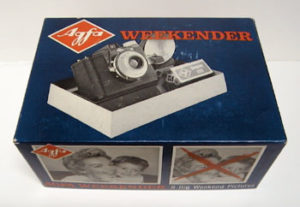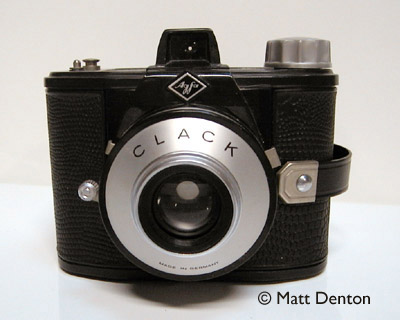- Produced 1954-65 Agfa-Werk AG, Munich, Germany
- Film type 120
- Picture size 6×9
- Weight 11.4oz (323.2g)
- Lens single element meniscus (about 95mm?)
- Focal range 1m to 3m with close-up setting, otherwise 3m – infinity
- Filter size built-in yellow filter (early models), accepts 30mm slip-on filters
- Aperture f11 (early model) or f11 + f16 (later model)
- Shutter self-cocking type, spring w/sliding aperture disc
- Shutter speeds one speed, 1/35, plus B
- Viewfinder simple direct viewfinder
- Exposure meter none
Overview
Some mysteries don’t take a detective to figure out: popular European family camera has a funny name, so it’s rebranded for the American market. The Agfa Clack was sold here in the US through Agfa’s New Jersey office as the Agfa Weekender.

The ‘Weekender’ came as a kit in a box with a clip-on ‘Clibo’ (Clibo-Blitz) flash that takes little Philips PF-1 bulbs, and a roll of Agfa Isopan film (in my case an empty metal canister). The box says ‘Agfa Weekender – 8 big weekend pictures!’ and has a 6×6 frame crossed out in favor of the bigger, bolder 6×9 frame. The thought as I understand it is that the pictures were contact-printed and so having bigger negatives was better. Actually, that might explain all the little sqare photos in my parents’ albums. Nah. They were probably from 126 cartridge cameras.
Somewhat ironically the Clack was superceded by the Agfa Click which was a 6×6 format, from about 1958 to 1970.
The Clack is basically a stylized box camera with an eye-level viewfinder, and has simple settings accordingly: one shutter speed plus a ‘B’ setting, three aperture/lens choices: ‘sunny’ (has a yellow filter), ‘cloudy’ (straight, no filter), and a close-up (magnifier) setting for pictures in the 1-3m range. Later models have an f16 aperture instead of the yellow filter, according to a reader.
To use, you sight with the simple viewfinder on top, which ends up being a decent approximation of the final image. The outer shell of the camera is made of steel – thin, strong and light. It’s embossed with a fake lizard skin pattern that I believe adds strength to the hull as well as giving it some character. The inside portion is plastic. Funny detail – like similar modified box cameras (Ansco Pioneer, Ansco Readyflash) the film plane is curved rather than flat, to help make up for the simple lens.
This camera is super-lighweight and small and feels like a toy. Until I used it myself, I found it a little hard to believe that it was a popular family camera in Europe at one time, considering all the other options they must have had during the period (1954-65). I don’t believe it ever caught on in the US, it appears to be a little scarce here, as opposed to say, Kodak brownies and all their offspring, and the very similar (in design if not in quality) Ansco Pioneer and Readyflash. However, the Clack produces very sharp, large negatives and is actually a very fun user, being lightweight and quirky. It’s as close to a medium-format point-and-shoot as you’re likely to see. The simplicity of fixed focus and simple settings make this a standout. If you see one, grab it.
There was a very similar 6×6 camera made by Kodak Ltd. London about the same time (1955-58) called the Cresta, which had a Kodet lens, and was followed by the Cresta II and Cresta III. The Cresta is notable for being the first Kodak camera to take 120 (as opposed to 620) rollfilm since the ’30s, and the Cresta III was possibly the last Kodak rollfilm camera. All things being equal, the Clack is at least more handsome than the Cresta.
Clibo-Blitz info: a couple of people emailed me to tell me about the bulb and battery. According to them the bulb size is Phillips PF1B or PF5B “Photoflux”, and you can apparently still get the battery as the Eveready/Energizer 412 or Varta 72PX.
Repairs
Apart from a crushed spot on the viewfinder, it’s in like-new shape and just needed a minor surface cleaning. Not much I can do about the viewfinder but it doesn’t affect the camera’s operation in the slightest. I covered it with a neatly trimmed piece of black electrical tape just so it looks a little better.
Tips & Tricks
Like many German cameras the whole back comes off for film loading. It’s actually more like a Chinese puzzle the way it fits together seamlessly. A lock on the bottom (ZU and AUF) draws and cinches the halves together. You open the back by turning the lever to AUF and slipping the film cage out of the outer shell. To load film: move the empty film spool to the side with the wind knob, and put the film in the other side. Draw the leader across the back and slip it into the takeup spool. Turn the wind knob a few times until the paper is tight, then put the cage into the back and lock it by turning the lever to ZU. Open the little window cover and wind on until you see the number 1 and you are ready to expose your first picture. No empty film spool? Your local photo lab may have one free for the asking.
Inside the back is a sticker: Isopan Agfacolor IF 17, which I presume is DIN 17 film (about ASA 40). I would assume it’s the recommended speed film for this camera though I will probably shoot 100-125. Speaking of that, I liked Jose Rios Lopez’ examples so much that I asked what he shot, and he told me Agfapan APX 100. Looks great! And all that Spanish in college finally paid off!
* Yellow filters are useful in black and white photography for increasing sky contrast and smoothing out skin tones, in fact it may be the most common colored filter used with black and white film. Here in the model I have one is built-in so you don’t have to worry about filter adapters, but if you must you can use a 30mm slip-on filter or adapter. However I’m told that they don’t all have a built-in yellow filter, I’m guessing perhaps just the late models do.
Oh yes – unlike most box style cameras this camera actually has a cable release socket (standard thread) and tripod mount (1/4″) in addition to the little retractable handle.
Related Links
- Alfred as usual has all you ever wanted to know and more about the Clack on his wonderful camera page
- Roland and Caroline have one
- Una pagina en espanol con buenos ejemplos de fotos
- Want more proof it takes beautiful photos? Ralph’s Clack page has some truly outstanding samples. Wow!
